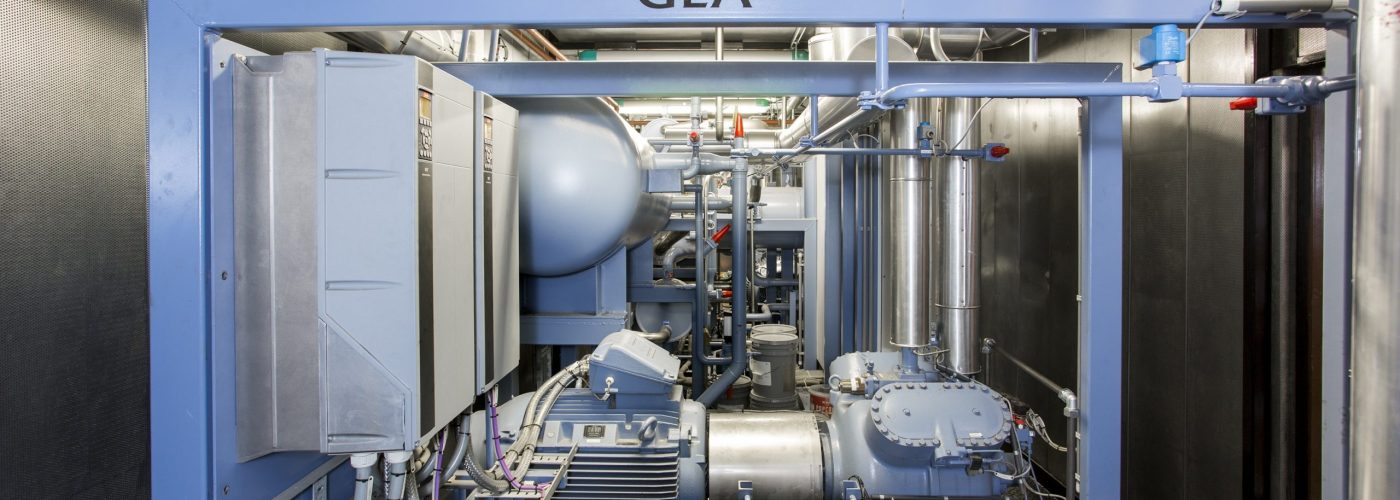The idea is as ingenious as it is unique and has the potential to become a global role model: the Bunhill Heat and Power Network (BHPN) project in central London. By using waste heat from the London Underground network, 1,350 homes, a school and two leisure centers in Islington are now heated and supplied with hot water as part of the council’s efforts to reduce carbon emissions and achieve CO2 neutrality by 2030.
In partnership with main contractors Colloide Engineering Systems, global technology specialist GEA supplied a purpose built heat pump solution for this flagship project, the first of its kind in the world. Bunhill 2 Energy Centre represents a real blueprint for the use of waste heat from public facilities, taking advantage of state-of-the-art technology on the site of the former City Road London Underground station which was decommissioned almost 100 years ago. The remains of the station have now been converted into a huge underground air extraction system that draws warm air from the tunnels underneath, still used by the London Underground’s Northern Line.
In close cooperation with Islington Council, Transport for London (TfL) and Colloide, GEA installed a 1000 kW ammonia heat pump, housed within a container at street level. The heat pump extracts the energy from warm exhaust air from the underground tunnels. The slightly cooler air is vented to the ambient and energy is used to heat up water by the heat pump, which is pumped through a 1.5 km network of district heating pipes to the buildings in the neighborhood, where it is finally used to heat the buildings.
The heat pump developed and manufactured by GEA for the system consists of a combined evaporator/separator, three compressors and four heat exchangers in the heating circuit. The heat exchangers optimize the heating circuit according to criteria based on the return of heating water at 55 degrees Celsius and the supply up to 80˚C.
According to Kenneth Hoffmann, Product Manager for Heat Pumps at GEA Refrigeration Technologies, there were many challenges in the design of the system during the project. These included extensive testing to ensure that dust and dirt sucked into the ventilation air would not clog the heat exchanger coil.
Kenneth Hoffmann explained: “Since the project was located next to a residential building, the installation also included a scrubber technology to filter the ventilation air from the plant room. In the very unlikely event of a small amount of the natural refrigerant ammonia escaping into the plant room, the local residents would not be exposed to the ammonia in the air, as it would be absorbed in the scrubber before being vented to ambient. The use of heat pumps is much more environmentally friendly than the use of gas boilers, especially in big cities, as they do not emit nitrogen oxides (NOx). Heat pumps therefore lead to cleaner air in cities and pay off financially. Moreover, ammonia is a natural refrigerant that does not contribute to global warming.”
Paddy McGuinness, Managing Director of Colloide Engineering Systems, added: “Colloide have been involved in a large number of renewable energy projects. Colloide partnered with GEA Refrigeration UK Ltd on this project for their knowledge of ammonia refrigeration and heat pump technology. Based on GEA’s experience, 95% of the industrial refrigeration plants installed over the last 10 years have been ammonia based. With the increasing pressure on end users to reduce energy bills, this has brought about a big increase in the interest of ammonia heat pumps.”
The Bunhill 2 Energy Centre adds a further 550 homes and a primary school to the existing Bunhill Heat and Power district heating network, originally launched by Islington Council in 2012. The heating costs for residents connected to the network will be cut by 10 percent when compared to other existing communal heating systems, which themselves cost around half as much as standalone systems heating individual homes. So, a real benefit to the environment, to residents and to Islington with the aim of ending fuel poverty.
The heating system is particularly environmentally friendly as it reuses heat that would otherwise be wasted. Supplying the connected households and public facilities with the upgraded waste heat will help to reduce CO2 emissions in the Islington Borough by around 500 tons per year.
Shaun Hannon, Contracts Manager at Colloide, commented: “Thanks to the cooperation of all involved, this is a ground-breaking district heating scheme. The main technology used is the ammonia heat pump and as a result, this project provides cheaper, greener energy for the local community.”
Iain Eckett, Technical Sales Manager, Refrigeration Technologies, GEA UK, concluded: “This was a very ambitious task. But we have shown that GEA has the knowledge, the technology and the ability to successfully implement innovative projects to generate cleaner and cheaper heating. We offer the most efficient solution at an attractive price.”
The principle of heat recovery using heat pumps can be applied in London and in underground networks all around the world. London alone has more than 150 ventilation shafts where waste heat could potentially be recovered. GEA heat pump technology, coupled with the experience gained from groundbreaking projects like the Bunhill 2 Energy Centre in Islington, has made GEA a trusted and preferred partner for waste heat projects globally.
Further information is available at www.gea.com





